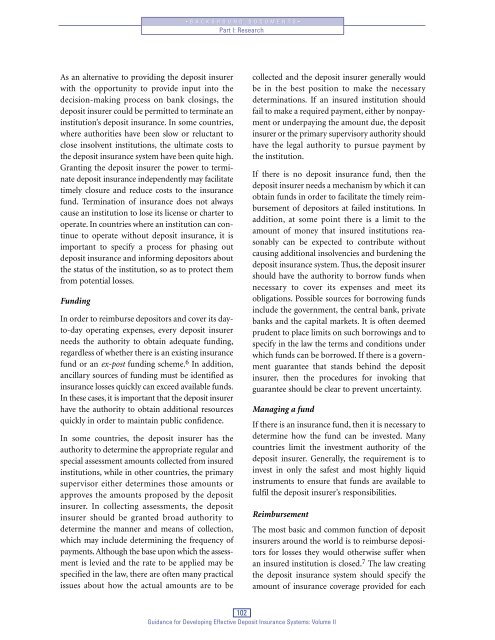Volume II - PDF - International Association of Deposit Insurers
Volume II - PDF - International Association of Deposit Insurers
Volume II - PDF - International Association of Deposit Insurers
- No tags were found...
You also want an ePaper? Increase the reach of your titles
YUMPU automatically turns print PDFs into web optimized ePapers that Google loves.
•BACKGROUND DOCUMENTS•<br />
Part I: Research<br />
As an alternative to providing the deposit insurer<br />
with the opportunity to provide input into the<br />
decision-making process on bank closings, the<br />
deposit insurer could be permitted to terminate an<br />
institution’s deposit insurance. In some countries,<br />
where authorities have been slow or reluctant to<br />
close insolvent institutions, the ultimate costs to<br />
the deposit insurance system have been quite high.<br />
Granting the deposit insurer the power to terminate<br />
deposit insurance independently may facilitate<br />
timely closure and reduce costs to the insurance<br />
fund. Termination <strong>of</strong> insurance does not always<br />
cause an institution to lose its license or charter to<br />
operate. In countries where an institution can continue<br />
to operate without deposit insurance, it is<br />
important to specify a process for phasing out<br />
deposit insurance and informing depositors about<br />
the status <strong>of</strong> the institution, so as to protect them<br />
from potential losses.<br />
Funding<br />
In order to reimburse depositors and cover its dayto-day<br />
operating expenses, every deposit insurer<br />
needs the authority to obtain adequate funding,<br />
regardless <strong>of</strong> whether there is an existing insurance<br />
fund or an ex-post funding scheme. 6 In addition,<br />
ancillary sources <strong>of</strong> funding must be identified as<br />
insurance losses quickly can exceed available funds.<br />
In these cases, it is important that the deposit insurer<br />
have the authority to obtain additional resources<br />
quickly in order to maintain public confidence.<br />
In some countries, the deposit insurer has the<br />
authority to determine the appropriate regular and<br />
special assessment amounts collected from insured<br />
institutions, while in other countries, the primary<br />
supervisor either determines those amounts or<br />
approves the amounts proposed by the deposit<br />
insurer. In collecting assessments, the deposit<br />
insurer should be granted broad authority to<br />
determine the manner and means <strong>of</strong> collection,<br />
which may include determining the frequency <strong>of</strong><br />
payments. Although the base upon which the assessment<br />
is levied and the rate to be applied may be<br />
specified in the law, there are <strong>of</strong>ten many practical<br />
issues about how the actual amounts are to be<br />
collected and the deposit insurer generally would<br />
be in the best position to make the necessary<br />
determinations. If an insured institution should<br />
fail to make a required payment, either by nonpayment<br />
or underpaying the amount due, the deposit<br />
insurer or the primary supervisory authority should<br />
have the legal authority to pursue payment by<br />
the institution.<br />
If there is no deposit insurance fund, then the<br />
deposit insurer needs a mechanism by which it can<br />
obtain funds in order to facilitate the timely reimbursement<br />
<strong>of</strong> depositors at failed institutions. In<br />
addition, at some point there is a limit to the<br />
amount <strong>of</strong> money that insured institutions reasonably<br />
can be expected to contribute without<br />
causing additional insolvencies and burdening the<br />
deposit insurance system. Thus, the deposit insurer<br />
should have the authority to borrow funds when<br />
necessary to cover its expenses and meet its<br />
obligations. Possible sources for borrowing funds<br />
include the government, the central bank, private<br />
banks and the capital markets. It is <strong>of</strong>ten deemed<br />
prudent to place limits on such borrowings and to<br />
specify in the law the terms and conditions under<br />
which funds can be borrowed. If there is a government<br />
guarantee that stands behind the deposit<br />
insurer, then the procedures for invoking that<br />
guarantee should be clear to prevent uncertainty.<br />
Managing a fund<br />
If there is an insurance fund, then it is necessary to<br />
determine how the fund can be invested. Many<br />
countries limit the investment authority <strong>of</strong> the<br />
deposit insurer. Generally, the requirement is to<br />
invest in only the safest and most highly liquid<br />
instruments to ensure that funds are available to<br />
fulfil the deposit insurer’s responsibilities.<br />
Reimbursement<br />
The most basic and common function <strong>of</strong> deposit<br />
insurers around the world is to reimburse depositors<br />
for losses they would otherwise suffer when<br />
an insured institution is closed. 7 The law creating<br />
the deposit insurance system should specify the<br />
amount <strong>of</strong> insurance coverage provided for each<br />
102<br />
Guidance for Developing Effective <strong>Deposit</strong> Insurance Systems: <strong>Volume</strong> <strong>II</strong>
















